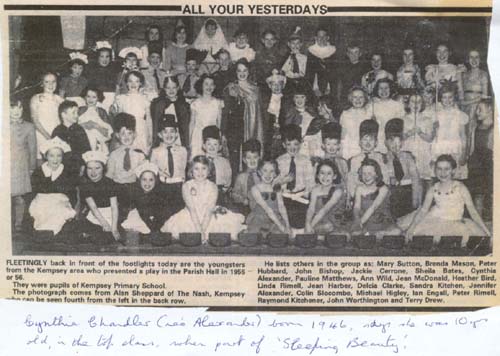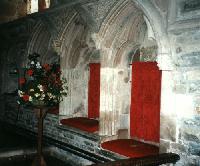
On this page:
|
Hillside Estate in the north of the village between the A38 and the river was built in the mid-1950s. For some of the new residents it was the first time that they had lived in homes with water that was not from a well or pump, and with electricity.
In 1956 the Kempsey Primary School play was 'Sleeping Beauty'.
"Fleetingly back in front of the footlights today are the youngsters from the Kempsey area who presented a play in the parish hall in 1955 or 56.
They were pupils of Kempsey primary school.
The photograph comes from Alan Sheppard of the Nash, Kempsey who can be seen fourth from the left in the back row.
He lists the others in the group as: Mary Sutton, Brenda Mason, Peter Hubbard, John Bishop, Jackie Cerrone, Sheila Bates, Cynthia Alexander, Pauline Matthews, Ann Wild, Jean McDonald, Heather Bird, Linda Rimell, Jean Harber, Delcia Clerke, Sandra Kitchen, Jennifer Alexander, Colin Slocombe, Michael Higley, Ian Engall, Peter Rimell, Raymond Kitchener, John Worthington, and Terry Drew."
The note below reads: "Cynthia Chandler (neé Alexander), born 1946, says she was 10 yrs old, in the top class, when part of 'Sleeping Beauty'."

Court House Excavations
In 1956 the Court House Excavations in Kempsey found Iron Age and Roman pottery near the church.
From Montague-Youens, Edward (Rev.) (1960) Brief History of The Church of St. Mary the Virgin.
In the post-war period the Victorian altar was removed, placed in the North Transcept,
and the Lady Chapel was re-dedicated by the present1
Bishop of Worcester in 1956. The side curtains are made of the same cloth as was used for
the Queen's coronation2. The new high
altar, proportionately wide to the great East window3,
was brought into use at the same time. The  red hangings and
cushions for the sedila were part of the same plan to provide the simple dignity of the
spacious east end of the church. Shortly afterwards4
the east window was completed by the provision of three stained glass panels in the lowest
course. Previously these panels had been obscured by the reredos5
of the altar, and had been left in plain glass.
red hangings and
cushions for the sedila were part of the same plan to provide the simple dignity of the
spacious east end of the church. Shortly afterwards4
the east window was completed by the provision of three stained glass panels in the lowest
course. Previously these panels had been obscured by the reredos5
of the altar, and had been left in plain glass.
Notes:
|
© 2000 Andy Morrall
Last updated 4th June 2000.
E-mail: andymorrall@geocities.com
 hits since 4th June 2000.
hits since 4th June 2000.